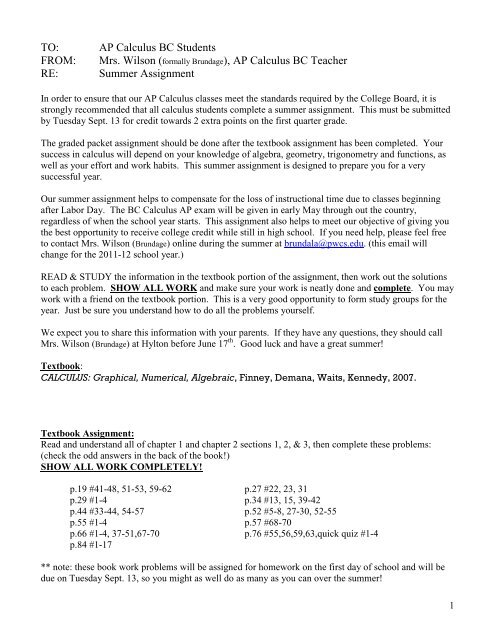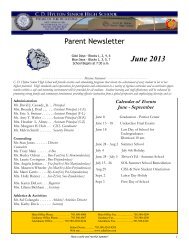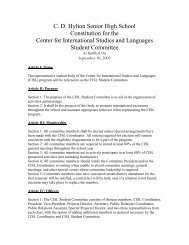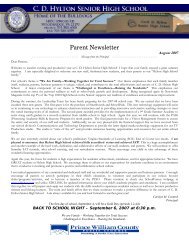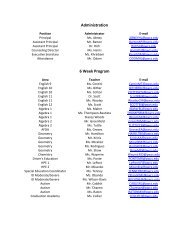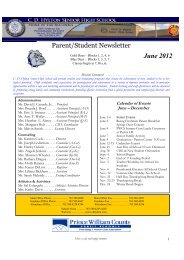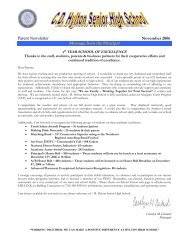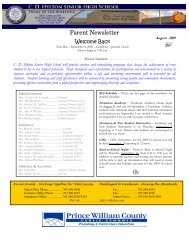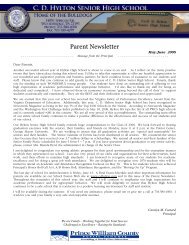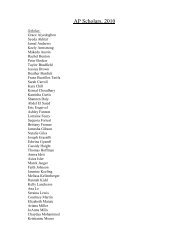AP Calculus BC - CD Hylton High School
AP Calculus BC - CD Hylton High School
AP Calculus BC - CD Hylton High School
You also want an ePaper? Increase the reach of your titles
YUMPU automatically turns print PDFs into web optimized ePapers that Google loves.
TO:<br />
FROM:<br />
RE:<br />
<strong>AP</strong> <strong>Calculus</strong> <strong>BC</strong> Students<br />
Mrs. Wilson (formally Brundage), <strong>AP</strong> <strong>Calculus</strong> <strong>BC</strong> Teacher<br />
Summer Assignment<br />
In order to ensure that our <strong>AP</strong> <strong>Calculus</strong> classes meet the standards required by the College Board, it is<br />
strongly recommended that all calculus students complete a summer assignment. This must be submitted<br />
by Tuesday Sept. 13 for credit towards 2 extra points on the first quarter grade.<br />
The graded packet assignment should be done after the textbook assignment has been completed. Your<br />
success in calculus will depend on your knowledge of algebra, geometry, trigonometry and functions, as<br />
well as your effort and work habits. This summer assignment is designed to prepare you for a very<br />
successful year.<br />
Our summer assignment helps to compensate for the loss of instructional time due to classes beginning<br />
after Labor Day. The <strong>BC</strong> <strong>Calculus</strong> <strong>AP</strong> exam will be given in early May through out the country,<br />
regardless of when the school year starts. This assignment also helps to meet our objective of giving you<br />
the best opportunity to receive college credit while still in high school. If you need help, please feel free<br />
to contact Mrs. Wilson (Brundage) online during the summer at brundala@pwcs.edu. (this email will<br />
change for the 2011-12 school year.)<br />
READ & STUDY the information in the textbook portion of the assignment, then work out the solutions<br />
to each problem. SHOW ALL WORK and make sure your work is neatly done and complete. You may<br />
work with a friend on the textbook portion. This is a very good opportunity to form study groups for the<br />
year. Just be sure you understand how to do all the problems yourself.<br />
We expect you to share this information with your parents. If they have any questions, they should call<br />
Mrs. Wilson (Brundage) at <strong>Hylton</strong> before June 17 th . Good luck and have a great summer!<br />
Textbook:<br />
CALCULUS: Graphical, Numerical, Algebraic, Finney, Demana, Waits, Kennedy, 2007.<br />
Textbook Assignment:<br />
Read and understand all of chapter 1 and chapter 2 sections 1, 2, & 3, then complete these problems:<br />
(check the odd answers in the back of the book!)<br />
SHOW ALL WORK COMPLETELY!<br />
p.19 #41-48, 51-53, 59-62 p.27 #22, 23, 31<br />
p.29 #1-4 p.34 #13, 15, 39-42<br />
p.44 #33-44, 54-57 p.52 #5-8, 27-30, 52-55<br />
p.55 #1-4 p.57 #68-70<br />
p.66 #1-4, 37-51,67-70 p.76 #55,56,59,63,quick quiz #1-4<br />
p.84 #1-17<br />
** note: these book work problems will be assigned for homework on the first day of school and will be<br />
due on Tuesday Sept. 13, so you might as well do as many as you can over the summer!<br />
1
<strong>AP</strong> <strong>Calculus</strong> <strong>BC</strong><br />
Summer Assignment<br />
Show all work in this packet.<br />
1. Find the x-intercept(s): 3x 2 + 2y 2 + 4xy – 12 = 0.<br />
A. ± 6 B. ± 2 C. 4 D. 6 E. None of these<br />
2. Find all the intercepts:<br />
x 1<br />
y = −<br />
x + 3<br />
A. (1 , 0), (0, -1/3) B. (1, 0) C. (-3, 0), (1, 0) D. (-3, 0), (0, -1/3) E. none of these<br />
3. Identify the type(s) of symmetry: x 4 y 2 + 2x 2 y – 1 = 0<br />
A. x-axis B. y-axis C. origin D. both x- and y-axis E. none of these<br />
4. Find the equation of the line that passes through (1, 3) and is perpendicular to the line 2x + 3y + 5 = 0.<br />
A. 3x – 2y + 3 = 0 B. 2x + 3y – 11 = 0 C. 2x + 3y – 9 = 0<br />
D. 3x – 2y – 7 = 0 E. none of these<br />
5. Find the equation of the line through (4, 2) and perpendicular to the line through (9, 7) and (11, 4).<br />
2<br />
3<br />
3<br />
A. y= ( x− ) + B. y=− ( x− ) + C. y ( x )<br />
3<br />
9 7<br />
2<br />
D. y ( x )<br />
=<br />
3<br />
− 4 + 2 E. none of these<br />
2<br />
9 7<br />
=−<br />
2<br />
− 4 + 2<br />
6. Find the domain of f ( x)<br />
A. ⎛ 3 ⎞<br />
−∞ , B. ⎡3 ⎞<br />
⎜ ⎟<br />
,<br />
⎝ 2 ⎠<br />
⎢<br />
∞ ⎟<br />
⎣2<br />
⎠<br />
=<br />
1 .<br />
3−<br />
2x<br />
C. ⎛3 ⎞<br />
⎜ , ∞⎟<br />
⎝2<br />
⎠<br />
D.<br />
⎛ 3 3<br />
⎜−∞, ⎞ ⎟ ⎛ ⎜ , ∞<br />
⎞<br />
⎟<br />
E. none of these<br />
⎝ 2⎠ ⎝2<br />
⎠<br />
2
7. Find<br />
f ( x+ h) − f ( x)<br />
2<br />
if f ( x) = 2x<br />
+ 3<br />
h<br />
A. 4x + 2h B. 2h 2 + 3 C. 2h + 3/h D. 4hx + 2h 2 E. none of these<br />
8. Given f ( x) x 2 3x 4, find f ( x 2) f ( 2)<br />
= − + + − .<br />
A. x 2 – 3x + 4 B. x 2 + x C. x 2 + x – 8 D. x 2 – 3x – 4 E. none of these<br />
f x = 3x − x + 2<br />
9. Is the following function even or odd? ( )<br />
4 2<br />
A. odd B. even C. both D. neither<br />
10. If ( )<br />
2<br />
f x = 1− x and g( x)<br />
( )<br />
1<br />
= , find f g( x ) .<br />
x<br />
A.<br />
1−<br />
x<br />
x<br />
2<br />
B.<br />
1<br />
1−<br />
x<br />
2<br />
C.<br />
1<br />
1− D.<br />
x<br />
1<br />
x<br />
2<br />
+ 1− x E. none of these<br />
⎛ f ⎞<br />
⎜ ⎟<br />
⎝ g ⎠<br />
11. Given f(x) = 6x – 12 and g(x) = x 2 – 4, find ( x)<br />
A.<br />
6<br />
x − 2<br />
B.<br />
( x − )<br />
6 2<br />
x + 2<br />
6<br />
C.<br />
( x+ 2 )( x−2<br />
)<br />
D.<br />
6<br />
x + 2<br />
E. none of these<br />
12. Given f(x) = 2x 2 + 1 and g(x) = x – 2, find f ( g( x )).<br />
A. x 2 – 7 B. 2x 2 + 2x – 1 C. 2x 2 – 1 D. 2x 2 – 8x + 9 E. none of these<br />
13. Match the graph to the right with the correct function.<br />
x + 3<br />
x 1<br />
x −1<br />
=<br />
x + 2x−3<br />
A. f ( x)<br />
= B. f ( x) = x+<br />
3<br />
−<br />
C. f ( x) 2<br />
E. none of these<br />
D. f ( x)<br />
x<br />
=<br />
2<br />
+ 2x−3<br />
x −1<br />
3
14. Find all vertical asymptotes of f ( x)<br />
2x<br />
−1<br />
=<br />
x + 3<br />
A. x = 2 B. x = ½, x = -3 C. x = -3 D. x = ½ E. none of these<br />
15. Using the figure to the right, solve for x:<br />
A.<br />
6<br />
3<br />
B. 6 C. 3 2<br />
3 30º<br />
x<br />
D. 3 E. none of these<br />
16. If<br />
π<br />
2<br />
< θ < π and sin θ=<br />
, find sin2θ .<br />
2 3<br />
A.<br />
4 5<br />
− B. 4 9<br />
3<br />
C. 4 5<br />
9<br />
D. – 4 3<br />
E. none of these<br />
17. Solve the given equation for<br />
≤ θ < π θ + θ = .<br />
2<br />
0 2 : 2sin sin 1<br />
π π 2π 3π<br />
A. 0, , π B. , ,<br />
2<br />
3 3 2<br />
C.<br />
π 5π 3π<br />
, ,<br />
6 6 2<br />
D.<br />
π 3π<br />
,<br />
6 2<br />
E. none of these<br />
18. A rectangle is bounded by the x-axis and the semicircle<br />
rectangle as a function of x.<br />
y<br />
2<br />
= 25 − x . Write the area A of the<br />
A. y = 12 B. y = 3x C. y = 8x D.<br />
y x x<br />
2<br />
= 2 25 − E. none of these<br />
19. Describe how the graph of f ( x) =−2 3− x + 5 can be obtained from the graph of g( x)<br />
= x.<br />
A. reflect through y-axis, shift left 3, reflect through x-axis, vertical stretch by 2, shift up 5.<br />
B. reflect through y-axis, shift right 3, reflect through x-axis, vertical stretch by 2, shift up 5<br />
C. reflect through y-axis, shift right 5, reflect through x-axis, vertical stretch by 2, shift up 3<br />
D. reflect through x-axis, shift left 3, vertical stretch by 2, shift down 5<br />
E. reflect through y-axis, shift left 3, reflect through x-axis, vertical stretch by 2, shift down 5<br />
4
20. Write a formula for the function graphed on the right<br />
A. f ( x)<br />
C. f ( x)<br />
⎧ 5 − x , 0≤ x ≤2<br />
⎪<br />
=<br />
2<br />
⎨<br />
⎪ 5<br />
x− 10, 2 < x≤4<br />
⎪⎩ 2<br />
⎧5 x , 0 ≤ x≤<br />
2<br />
⎪<br />
=<br />
2<br />
⎨<br />
⎪− 5<br />
x + 10, 2 < x ≤ 4<br />
⎪⎩ 2<br />
B. f ( x) =− x + 5<br />
D. f ( x) =− x−<br />
2<br />
E. none of these<br />
21. Give the equation for the graph after the following transformations have been applied to the graph of<br />
y = x 2 : vertical stretch by 2, reflect through the x-axis, shift right 2, shift up 3.<br />
A. y = ( −2x− 2) 2<br />
+ 3 B. y =− 2( x+ 2) 2<br />
+ 3 C. y ( x ) 2<br />
D. y = 2( −x− 2) 2<br />
+ 3 E. y ( x ) 2<br />
=− 2 + 2 − 3<br />
=−2 − 2 + 3<br />
22. f(x) = |6 + 8x| is equivalent to which piecewise function?<br />
A. f ( x)<br />
C. f ( x)<br />
⎧6+ 8 x,<br />
x≥−<br />
= ⎨<br />
⎩ − 8x<br />
− 6, x −<br />
23. Find the value of log8<br />
32 .<br />
3<br />
4<br />
3<br />
4<br />
3<br />
4<br />
3<br />
4<br />
B. f ( x)<br />
D. f ( x)<br />
⎧6+ 8 x,<br />
x≤−<br />
= ⎨<br />
⎩ − 8x<br />
− 6, x >−<br />
⎧6+ 8 x,<br />
x≥−<br />
= ⎨<br />
⎩6 − 8 x,<br />
x
1<br />
− − =<br />
2<br />
A. -1 B. 3 and -2 C. 3 only D. no solutions E. none of these<br />
26. Solve for x: log ( 2<br />
9<br />
x x 3)<br />
27. Solve for x: ( x )<br />
log 15 + 5 − log x=<br />
2<br />
5 5<br />
A. 2 B. ½ C. -1 D. 5 E. none of these<br />
28. Eliminate the parameter: x = t – 3 y = t 2 – 2t – 1<br />
A. y = x 2 + 4x + 2 B. y = x 2 + 4x + 14 C. y = x 2 – 2x + 14<br />
D. y = x 2 – 2x + 2 E. none of these<br />
29. For the equation y = x 2 – 3x + 5, find the y-component of its parametric equation by letting x = t – 2.<br />
A. y = t 2 – 3t + 3 B. y = t 2 – 3t + 15 C. y = t 2 – 7t + 3<br />
D. y = t 2 – 7t + 15 E. none of these<br />
30. This is the grade I will receive in <strong>AP</strong> <strong>Calculus</strong> <strong>BC</strong><br />
A. A B. B+ C. B D. C+ E. Mrs. Wilson doesn’t want to know<br />
31. If the population of mosquitoes doubles every hour and there are 175 flies initially, approximate how<br />
many mosquitoes will be present after 6.5 hours, assuming that none die.<br />
A. 2,275 B. 11,927 C. 15,839 D. 18,300 E. none of these<br />
ax<br />
32. An exponential curve is in the form of y = Ce . If the curve has a y-intercept of 10 and passes<br />
through the point (5, 5), find the value of a.<br />
A. -0.139 B. -0.693 C. 0.693 D. 0.139 E. none of these<br />
33. The graph of r = 5cos 2θ<br />
has how many loops?<br />
A. none B. 2 C. 4 D. 5 E. none of these<br />
6
34. The graph to the right could be which of the following polar equations?<br />
A. r = 4θ<br />
B. r = 4cos 2θ<br />
C. r = 4 + cosθ<br />
D. r = 1+ 4cosθ<br />
E. none of these<br />
35. f(x) decreases without bound as x approaches what value from the right when f ( x)<br />
+<br />
−<br />
−<br />
+<br />
A. x → 5 B. x → 3 C. x → 5 D. x → 3 E. none of these<br />
=<br />
4<br />
( x−3)( 5−x)<br />
.<br />
36. Evaluate:<br />
x<br />
−<br />
lim<br />
2<br />
4<br />
x→3<br />
A. 1 B. 5 C. -1 D. 5 E. none of these<br />
37. Evaluate:<br />
x<br />
lim<br />
x→4<br />
2<br />
− 5x+<br />
4<br />
x − 4<br />
A. 0 B. -1 C. 3 D. DNE E. none of these<br />
38. Evaluate:<br />
lim<br />
x→3<br />
x − 3<br />
x − 3<br />
A. 0 B. 1 C. 3 D. DNE E. none of these<br />
39. If lim f ( x) = 2 and lim g( x) = 6, then find lim ⎡f ( x) − 2 f ( x) g( x) + g( x)<br />
x→c x→c x→c<br />
2 2 ⎤<br />
⎣ ⎦ .<br />
A. 40 B. -4 C. 16 D. 28 E. none of these<br />
40. Evaluate: lim( 3x<br />
2 + 5)<br />
x→2<br />
A. 41 B. 17 C. 11 D. 0 E. none of these<br />
7
Use the graph to the right to answer #41-42.<br />
41. Which defined function matches the graph?<br />
A. f ( x)<br />
C. f ( x)<br />
⎧x+ 3, x≠3<br />
= ⎨<br />
⎩1, x = 3<br />
⎧3 −x, x≠1<br />
= ⎨<br />
⎩1, x = 1<br />
B. f ( x)<br />
D. f ( x)<br />
⎧x+ 3, x≠1<br />
= ⎨<br />
⎩1, x = 1<br />
⎧3 −x, x≠2<br />
= ⎨<br />
⎩1, x = 2<br />
E. none of these<br />
42. Find lim f ( x)<br />
x→1<br />
.<br />
A. 1 B. 2 C. 3 D. DNE E. none of these<br />
Use the graph to the right to answer #43-44.<br />
43. Which defined function matches the graph?<br />
A. f ( x) =<br />
2<br />
x −1<br />
x −1<br />
B. f ( x)<br />
1<br />
=<br />
x + 1<br />
1<br />
x 1<br />
C. f ( x)<br />
= D. f ( x )<br />
−<br />
E. none of these<br />
=<br />
1<br />
( x + 1) 2<br />
44. Find lim f ( x)<br />
x→−1<br />
.<br />
A. 0 B. 1 C. DNE D. −∞ E. none of these<br />
45. Find<br />
x<br />
lim<br />
x→−1<br />
2<br />
+ 3x+<br />
2<br />
.<br />
2<br />
x + 1<br />
A. 0 B. ∞ C. -1 D. DNE E. none of these<br />
8
46. Find<br />
lim−<br />
x→6<br />
6<br />
3x<br />
−18<br />
− x<br />
A. -1 B. 1 C. 3 D. -3 E. none of these<br />
1<br />
f x = and g x = x − 5<br />
x + 1<br />
47. Let ( ) ( )<br />
2<br />
. Find all values of x for which f ( g( x ))<br />
is discontinuous.<br />
A. -1 B. -1 and ± 5 C. ± 5 D. -2 and 2 E. none of these<br />
48. Determine the value of c so that f(x) is continuous for all real numbers if f ( x)<br />
A. -4 B. -2 C. 2 D. 4 E. none of these<br />
⎧x+ 3, x≤−1<br />
= ⎨<br />
⎩2 x− c, x>−1<br />
⎛ 5 ⎞<br />
49. Find lim⎜2<br />
+<br />
x→0<br />
2 ⎟<br />
⎝ x ⎠ .<br />
A. 7 B. 2 C. ∞ D. - ∞ E. none of these<br />
50. Find<br />
1<br />
lim<br />
x<br />
+<br />
x→0<br />
A. ∞ B. 0 C. - ∞ D. DNE, since the right and left hand limits are not equal E. none of these<br />
51. Find<br />
⎛<br />
lim 2 −<br />
x→1<br />
⎜<br />
⎝<br />
5<br />
( x − 2) 2<br />
⎞<br />
⎟<br />
⎠<br />
A. - ∞ B. ∞ C. -3 D. 2 E. none of these<br />
52. Describe the slope at the indicated point P on the graph to the right.<br />
A. no slope B. positive C. negative<br />
P<br />
D. zero E. none of these<br />
9
53. At which point is the slope of the tangent line closest to zero on the graph shown below?<br />
A. A B. B C. C D. D E. E<br />
4 3<br />
54. Given f ( x) = 3x − 6x + 3x− 2, find '( )<br />
f x .<br />
A<br />
B<br />
C<br />
D<br />
E<br />
f ' x = 12x − 18x + 3x−<br />
2<br />
2 2<br />
4 3<br />
3 2<br />
A. f '( x) = 3x − 6x<br />
+ 3 B. f '( x) = 3x − 6x + 3x<br />
C. ( )<br />
f ' x = 12x − 18x<br />
+ 3 E. none of these<br />
D. ( )<br />
3 2<br />
55. Find the point(s) on the graph of the function ( )<br />
3<br />
f x = x − 2 where the slope is three.<br />
A. (1, 3) & (-1, 3) B. (1, -1) & (-1, -3) C. ( 3 2 , 0) D. (1, 3) E. none of these<br />
56. Where is the function f ( x) =<br />
2<br />
x<br />
5<br />
−2x−15<br />
discontinuous?<br />
A. x = -5 and x = -3 B. x = -5 and x = 3 C. x = -3 and x = 5<br />
D. x = 3 and x = 5 E. x = 2 and x = 15<br />
57. Find<br />
lim<br />
x→∞<br />
2<br />
3x<br />
+ 2x+<br />
1<br />
x + 1<br />
.<br />
A. 3 B. ∞ C. 3 D. 0 E.<br />
3<br />
2<br />
3/2<br />
58. If f ( x) = x , then find '4 ( )<br />
f .<br />
A. -6 B. -3 C. 3 D. 6 E. 8<br />
f x = 2x<br />
+ 1, then find<br />
59. If ( )<br />
2<br />
lim<br />
x→0<br />
( ) − ( 0)<br />
f x f<br />
x<br />
2<br />
.<br />
A. 0 B. 1 C. 2 D. 4 E. DNE<br />
10
−1<br />
60. Evaluate tan ( 1)<br />
.<br />
A. 1 B. -1 C.<br />
π<br />
2<br />
D.<br />
π<br />
4<br />
E. 0<br />
61. Solve the equation: sin x= cos x for 0≤ x < 2π<br />
.<br />
A.<br />
π 3π 5π 7π<br />
, , ,<br />
4 4 4 4<br />
π π<br />
B. ,<br />
3 6<br />
C.<br />
π 5π<br />
,<br />
4 4<br />
D.<br />
π 3π<br />
0, , π , E. none of these<br />
2 2<br />
63)<br />
64) Use synthetic division to divide 5x 4 – 13x 2 – 6x + 9 by x – 3<br />
65) Factor completely:<br />
A) 10(x + 8)(x – 7) 2 (x – 1) B) (x + 8)(x – 7) 2 (10x – 10)<br />
C) (x + 8)(x – 7) 2 (5x – 5) D) 2(x + 7)(x – 8) 2 (5x – 5)<br />
11
66) Simplify by writing as a single quotient with positive exponents.<br />
67) Express as a single logarithm:<br />
68) Evaluate the infinite geometric sum:<br />
69) Find the equation of the tangent line to the graph of f at the given point.<br />
70) The graph of f(x) is given on the right.<br />
lim f x<br />
Evaluate: ( )<br />
x→3<br />
A. 3 B. 5 C. 4<br />
D. DNE E. none of these<br />
12


